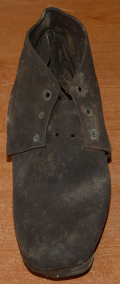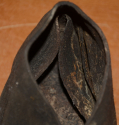site search
online catalog
ARMY SHOE FROM FORT PEMBINA, ND

$395.00
Quantity Available: 1
Item Code: 1052-386B
Shipping: Determined by Method & Location of buyer
To Order:
Call 717-334-0347,
Fax 717-334-5016, or E-mail
This soldier’s shoe is very similar to another found in the Fort Pembina excavations that has a partially visible US inspector’s mark and in construction differs only in having four sets of lace holes rather than three as this one does. They appear to be among the experimental patterns of footwear tried out by the army after the Civil War. There were large numbers of shoes and boots left over from the war, but by the early 1870s it was clear new patterns were needed to replace the Civil War shoes whose pegged or sewn soles that would not hold up on the rougher western terrain where heat shrank the leather and pegs dropped out from soles or rocky ground cut the stitching. (One veteran quipped that marching on southern roads, in contrast, they scarcely encountered “a pebble in a mile.”) Brass screws were introduced in 1872 and then later abandoned in favor of sewn soles again, and at the same time experiments were made with different shaped lasts and the contour of the soles in ongoing efforts to combine comfort, utility, and something of a soldier-like appearance, all amid a growing realization that different shoes might be needed for garrison duty versus active campaigning, or less active barracks life.
This shoe shows some Civil War characteristics in being constructed of rough-side-out black leather, now oxidized to a dusty brown with some white stains, with a counter inside the heel, and both stitching and a small hole for a rivet at the seam of the vamp and the quarters just above the instep. At the same time the toe is somewhat rounded, the heel is rather high, the three pairs of lacing holes have small grommets in them, and the sole is both contoured, very narrow at the instep (indicating it is for the left foot,) and shows two rows of rather large holes on either side of the instep, but only a single row of narrower holes around the forepart of the sole, indicating the instep may have been pegged, perhaps to permit it to be so narrow, but the remainder of the sole was sewn. This would be unusual, but it seems to be what is going on, even though the pegs and stitching are both gone. The forepart of the shoe, however, seems to have a welt on the side, which would also indicate a sewn sole. The leather has oxidized from black to brown and shows white stains, but the shoe is solid, stable, able to be handled, and displays very well.
Excavations at Fort Pembina, established in 1870, have been a treasure trove for study of the material culture of the postwar US frontier army. Anaerobic soil conditions have yielded cloth and leather showing continued use of Civil War issue gear, privately purchased material, later issue patterns, etc., and this is particularly the case with footwear, which is not unexpected. See McChristian’s volumes on uniforms and gear of the frontier army in the 1870s and 1880-1892 for details on the problems and attempted solutions. The problem was so vexing that Sherman, as General of the Army, threw up his hands in 1879, throwing the problem back upon the Quartermaster Department for several years, declaring, “There is no necessity of adopting any shoe as uniform. Soldiers should be permitted to buy any kind of shoe they please with their own money.”
Fort Pembina was situated in the Red River Valley in North Dakota near the Canadian border, established in 1870 and in operation until 1895. Trading posts existed earlier in the area as part of the fur trade, and the first U.S. military post there was temporary- manned by a detachment of Minnesota troops in 1863-1864 following the 1862 Sioux uprising. In March 1870 a new fort was established south of the Pembina River and about 200 yards west of the Red River, completed by July and named in honor of Gen. George H. Thomas. The name was changed to Fort Pembina in September and the initial garrison consisted of two companies of the 20th US Infantry and excavations show that, as is typical of the early Indian Wars regular army, their uniforms and gear were a mix of Civil War surplus issue, private purchase material, and later army issue patterns and private purchases as time went on. Their main duty was to provide security for settlers worried about Sioux returning south from Canada, but the troops were more occupied with escorting boundary surveys along the Canadian border and preventing Fenian raids heading north into Canada.
The fort included enlistedmen’s barracks, officers’ quarters, guard house, ordnance storehouse, company kitchen, root house, laundress’s quarters, quarters for civilian employees, hospital and hospital servant’s house, a barn for the “hospital cow,” quartermaster and commissary offices and storehouse, stables, wagon shed, etc. The garrison reached peak strength in 1878 at 200, but the average was about 125 enlisted men and 8 officers. An October 1885 return listed 97 men, 2 field pieces, 1 mountain howitzer, 100 rifles, 19 pistols, 23 mules, and 9 wagons. By 1890 the post had just 23 men, and after an 1895 fire destroyed some 19 buildings it was decided to abandon the fort rather than rebuild, the last detachment left in September. The property was turned over to the Interior Department and later sold in 1902. [sr] [ph:L]
~~~~~~~~~~~~~~~~~~~~~~~~~~~~~~~~~~~
THIS ITEM, AS WITH ALL OTHER ITEMS AVAILABLE ON OUR WEB SITE,
MAY BE PURCHASED THROUGH OUR LAYAWAY PROGRAM.
CLICK HERE FOR OUR POLICIES AND TERMS.
THANK YOU!
Inquire About ARMY SHOE FROM FORT PEMBINA, ND
For inquiries, please email us at [email protected]
Most Popular
Historical Firearms Stolen From The National Civil War Museum In Harrisburg, Pa »
Theft From Gravesite Of Gen. John Reynolds »
Selection Of Unframed Prints By Don Troiani »
Fine Condition Brass Infantry Bugle Insignia »
British Imported, Confederate Used Bayonet »
Scarce New Model 1865 Sharps Still In Percussion Near Factory New »
featured item
CIVIL WAR US NAVY LT. COMMANDER’S COAT AND BUCKLE OF ALEXANDER COLE RHIND - USS CONSTELLATION, USS CRUSADER, USS KEOKUK, FOUGHT CS BATTERIES AT DEEP BOTTOM, COMMANDED A “POWDER BOAT” AGAINST FT. FISHER, LATER REAR ADMIRAL
This is a very appealing regulation Civil War navy officer’s frock coat with interesting history. The coat is very dark blue, almost black, double-breasted with two rows of 9 US Navy officer’s button each down the front, two at the rear waist,… (1179-650). Learn More »
site search
Upcoming Events
May 16 - 18: N-SSA Spring Nationals, Fort Shenandoah, Winchester, VA Learn More »









